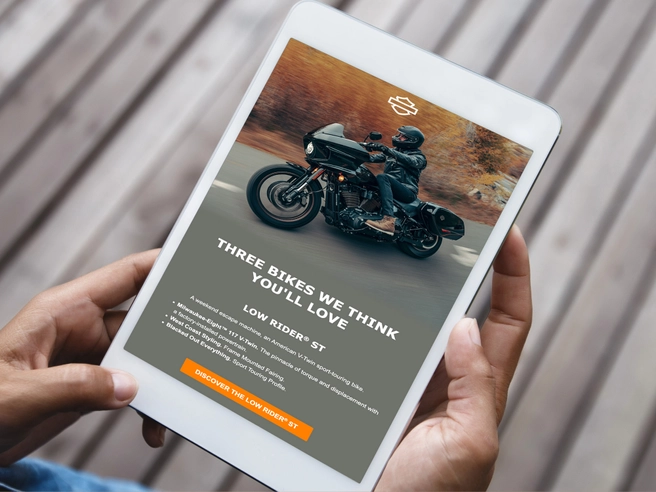
It’s an age-old question around email marketing: how do you ensure your emails don't get lost in the noise? The answer lies in personalised email marketing.
Imagine receiving an email that feels like it was crafted just for you, talking directly to your wants and needs. It really makes you feel like the brand understands you, right? This is the power of personalisation.
Personalised emails can deliver six times higher transaction rates than non-personalised ones, according to a study by Experian. Yet, despite this compelling statistic, 70% of brands aren't leveraging email personalisation effectively. This gap presents a golden opportunity for medium to large e-commerce companies to differentiate themselves and deepen their customer relationships.
But let's face it, personalisation at scale can seem daunting. It's more than just inserting a customer's name into an email. It requires understanding customer behaviour, preferences, and past interactions, then using this data to craft tailored content that resonates with each individual.
This blog will guide you through the maze of email personalisation, offering insights and strategies to help you implement it effectively in your e-commerce business.

Key strategies for effective personalisation
Achieving effective email personalisation at scale involves several key strategies.
Here’s how you can get started:
Data-driven customer insights
Data is the foundation of any personalised marketing strategy. To create personalised emails, you need to gather and analyse data about your customers. This includes demographic information, purchase history, browsing behaviour, and engagement with previous emails.
By leveraging tools like Customer Relationship Management (CRM) systems and analytics platforms, you can gain valuable insights into your customers' preferences and behaviours. These insights allow you to segment your audience more effectively and tailor your email content to meet their specific needs.
(As part of this process you may need to implement a new CRM or ESP. Here is a helpful blog on how to choose the right one for you. We also have a case study showing how impactful having the right CRM can be! )

Segmentation and targeting
Segmentation is the process of dividing your email list into smaller, more targeted groups based on specific criteria. This can be as simple as segmenting by age, gender, or location, or as complex as using behavioural data to create segments based on purchase history and browsing patterns.
Effective segmentation ensures that your emails are relevant to each recipient, which can significantly increase open and click-through rates.
(For a more in-depth look at segmentation tactics, check out our blog on advanced e-commerce audience segmentation tactics.)
Leveraging AI and machine learning
Artificial Intelligence (AI) and Machine Learning (ML) are game-changers when it comes to email personalisation. These technologies can analyse vast amounts of data to predict customer behaviour and automate the personalisation process.
For instance, AI can help you determine the best time to send emails to individual recipients, recommend products based on previous purchases, and even generate personalised content. This not only enhances the customer experience but also saves time and resources for your marketing team.
(A real-life example of this is our approach to Harley Davidson’s weekly e-commerce emails. A key aspect of this strategy uses AI for send time optimisation. Ensuring each recipient received the email at the right time for them, increasing the chances of engagement. Read the case study here.)
Building on existing data
Don't overlook the data you already have. Historical data from past email campaigns, purchase history, and customer feedback can be a gold mine of information. Use this data to identify patterns and trends that can inform your personalisation strategy.
For example, if you notice that a particular segment of customers tends to purchase more frequently during certain times of the year, you can tailor your email campaigns to target them with relevant offers during those periods.

Incorporating real-time decisions
personalisation doesn’t have to be static. Real-time data can be used to personalise emails at the moment they are opened. This can include displaying real-time product recommendations, current offers, or dynamic content based on the recipient's latest interactions with your website.
For instance, if a customer has abandoned a shopping cart, a real-time email can include the items they left behind along with a special discount to encourage them to complete the purchase. This level of personalisation can significantly boost conversion rates.
(We recently set up a series of automated abandon cart journeys for our client Annie Sloan, a heritage paint company. The journeys included real-time cart information as well as personalised recommendations. They drove immediate results and continue to be an effective conversion tool. Read the case study here.)
Steps to implement personalisation at scale
Now that we've explored the key strategies for effective personalisation, let's dive into the practical steps to implement these strategies at scale.
Here's a step-by-step guide to set you on the right path:
- Gather customer data
- Collect comprehensive data on your customers from your CRM, website analytics, and purchase history (either through reviewing existing data or collecting new data through customer outreach.)
- Ensure the data is clean and organised to provide accurate insights.
- Segment your audience
- Divide your email list into targeted groups based on demographics, behaviour, and purchase history.
- When you are ready utilise more advanced segmentation to create precise and relevant customer groups.
- Create personalised content:
- Develop email content that is tailored to each segment. This can include things like personalised subject lines, body content, and product recommendations.
- Use dynamic content blocks to customise messages based on real-time data.
- Implement automation:
- Use email marketing automation tools to send you personalised emails at the right time. Set up behaviour triggers for actions like cart abandonment or product views.
- Automate workflows to ensure consistent and timely communication with minimal manual effort.
- Leverage AI and machine learning:
- Incorporate AI to predict customer behaviour and personalise content dynamically.
- Use machine learning algorithms to optimise send times and content for each recipient.
(Many CRMs and ESP already incorporate the power of AI to help you get started! For example Salesforce Einstien or Hubspot AI)
- Test and optimise
- Conduct A/B testing on various email elements such as subject lines, images, and calls to action.
- Regularly analyse the results and refine your strategies based on performance data.
- Monitor and analyse results
- Track key metrics like open rates, click-through rates, and conversions.
- Use these insights to continually improve your personalisation efforts and achieve better outcomes.
By following these steps and continuously refining your approach, you can effectively implement personalisation at scale and reap the rewards of deeper customer engagement and increased conversions.

A key consideration: Data privacy and compliance
Data privacy and compliance are critical aspects that cannot be overlooked when leveraging customer data for personalisation. We wouldn’t be responsible marketers if we wrote a blog on this topic without talking about it!
As personalisation heavily relies on customer data, it's crucial to address data privacy concerns and compliance with relevant regulations. Adhering to laws such as the General Data Protection Regulation (GDPR) and the California Consumer Privacy Act (CCPA) is non-negotiable.
Ensure you have proper consent from customers before collecting and utilising their data for personalisation. Implement robust security measures to safeguard sensitive information from unauthorised access.
Maintaining transparency is key – clearly communicate your data practices in your privacy policy and provide options for customers to control how their data is used.
Neglecting data privacy regulations can result in hefty fines and tarnish your brand's reputation. By prioritising data privacy and compliance, you'll build trust with your audience and mitigate legal and reputational risks associated with personalised email marketing.
A final thought
Achieving email personalisation at scale is no small feat, but the rewards are well worth the effort. By leveraging data-driven insights, advanced segmentation, AI, and automation, you can create highly personalised email campaigns that resonate with your customers and drive meaningful engagement. Remember to continuously test, optimise, and refine your strategies to ensure ongoing success.
Partnering with an agency can further streamline this process, providing you with the expertise, tools, and tailored strategies needed to implement personalisation effectively and efficiently. Whether you're just getting started or looking to enhance your current efforts, the right agency partnership can make all the difference in achieving your email marketing goals. Explore our email marketing services.
Good luck with your email personalisation journey!